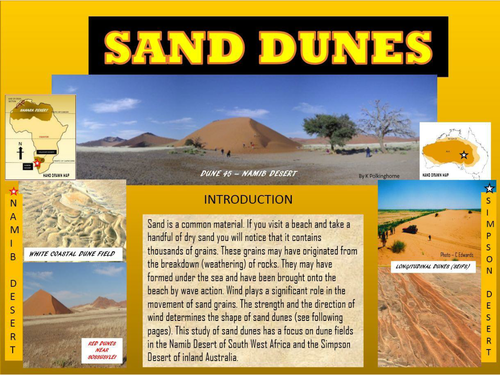

It's not difficult to understand that sand particles are small and can move. Try walking along a sandy beach or among sandy dunes on a windy day and you recognise the sand movement. Beaches and dunes are the accumulation of sand particles. This unit has a focus on two sand dune accumulations - one in SW Africa and the other in the Simpson Desert of inland Australia. The pages will reveal the source of sand; the movement of sand and the deposition of sand to form dunes. Venture into the giant red dunes of the Namibian Desert. See what happens when limited sand sources create barchan dunes (horn-shaped). Then travel across to Australia and venture across the Simpson Desert and tackle the hundreds of longitudinal dunes that adventurers need to tackle in 4 WD vehicles from Oodnadatta to Birdsville. Try planning a 4WD excursion for yourself. Take up the challenge contained in the attachment sheets (One with colour map; the other with a black and white map). Be tested by planning for the environment; the landscape and the sand dunes. Do not underestimate the challenge of the trip and the need for careful pre-trip planning. Otherwise your survival could be challenged. This unit could be used in lower-mid-secondary levels.
Something went wrong, please try again later.
This resource hasn't been reviewed yet
To ensure quality for our reviews, only customers who have downloaded this resource can review it
Report this resourceto let us know if it violates our terms and conditions.
Our customer service team will review your report and will be in touch.
£0.00
